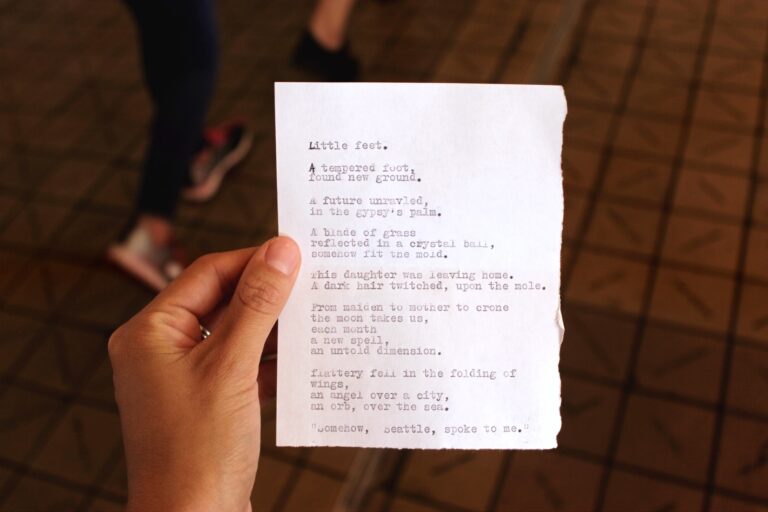Exploring the History, Definition, Rhyme Scheme and Examples of Rhyme in Poetry
Introduction
Rhyme, the lyrical glue, binds together some of history’s greatest poetry, from Shakespeare to Tennyson and beyond! It is a powerful poetic device that can drive us mad with delight…or leave us utterly perplexed as we try vainly to understand its complexities. But fear not! Today, we embark on an epic journey into the world of rhyme, exploring its fascinating history, definition and examples. In this article, you will learn all there is to know about this captivating literary tool- let your adventure begin!
When examining the origins of rhymes in poetry, one must look back centuries ago – right back to Ancient Greece, where Homer’s Iliad and Odyssey were first composed. Many literary historians consider these epics two of the oldest surviving works of literature known to humanity; they demonstrate how fundamental rhythmic patterns have been used since time immemorial for story-telling purposes. This idea spread throughout Europe during medieval times when troubadours popularised songs using rhyming couplets such as those found in Geoffrey Chaucer’s The Canterbury Tales and Edmund Spenser’s Faerie Queene.
Today, ‘rhyme’ has become a familiar concept within English poetry, but what exactly does it mean? To put it simply, ‘rhyme’ refers to words that share similar or identical sounds at their ends when spoken aloud (e.g., cat/hat). While traditional forms like ABAB or ABCB schemes still exist, contemporary poets often use more complex rhyming techniques such as slant-rhymes or half-rhymes, allowing them greater flexibility with language expression and creativity. As you’ll soon discover in this article below, there is no limit to the possibilities when crafting verse through rhyme – get ready for an exciting exploration!
Rhyme Definition
Rhyme is an integral poetry component to create aural texture and emphasize ideas. It describes the repetition of similar sounds in two or more words within or between lines, often at the end of each verse. There are several types of rhyme: perfect rhyme, near-rhyme (also known as slant rhyme), exact rhymes, and eye rhymes.
- Perfect rhyme involves identical vowel sounds with different consonants; for example “weep” and “sleep.”
- Near-rhyme uses similar but not identical vowel sounds; examples include “agree” and “free.”
- Exact rhymes combine both perfect and near-rhymes elements by using words that share only one element – either their vowels or consonants; for instance, “haste” and “taste.”
- Eye rhyme combines visual rather than auditory similarities, such as ‘thought’ and ‘though.’
Rhyming can contrast ideas, show irony or humor, enhance emotion, or draw attention to certain concepts. It also unifies stanzas, gives structure to poems, and adds musicality to language. Ultimately it adds beauty and depth to any poetic form.
Origin And Development Of Rhyme
The development of rhyme in poetry is a fascinating and complex history. It has been theorized that the earliest known examples of rhyming verse were those composed by ancient Babylonians and Sumerians around 2000 BC. Still, recent studies suggest this may not be true. While it is difficult to identify the originator of such a unique form of expression, there can be no doubt that rhyme became an integral part of poetic composition only centuries later.
Rhyme initially evolved as a tool for oral storytelling, often used to commemorate events or give moral instruction through songs and epics passed down from generation to generation. This tradition was continued in Ancient Greek literature, with writers like Homer incorporating rhymes into their works, many of which have survived until today. Similarly, the Romans had poets like Virgil, who defined the classical definition we use today when discussing literary techniques associated with rhyme schemes.
As time progressed, so too did the forms of poetry and its related techniques. During medieval times, troubadours popularised song lyrics while religious hymns began using repeating patterns throughout Europe. With printing presses invented during The Renaissance period, written poems became increasingly accessible, allowing authorship to broaden further still – eventually leading us up to our current day, where virtually all poetry features some kind of rhythmic sentiment.
It’s clear that over thousands of years, humans have found creative ways to incorporate rhythm into writing from various cultures worldwide – forming one global language expressed universally through art.
Common Types Of Rhyme
End rhyme typically involves matching the final stressed syllable in two or more words that conventionally share all sounds after the last stressed syllable. An example of an end rhyme would be “hat” and “cat.” Perfect rhymes are a type of end rhyme where the final syllables must perfectly match to be considered a valid form of rhyming. For instance, the words “tone” and “cone” would be perfect rhymes as they both contain identical vowel sounds at the end. Line rhymes involve repeating similar-sounding words throughout poetry, usually following a specific rhyme scheme such as ABCD (where each line ends with different rhyming words).
A writer might use this technique by repeating certain vowels or consonants within a single line or multiple lines; for example, echoing one word such as “used” several times in different lines. Eye rhymes also exist when two or more words appear to have similar endings but don’t actually share any sound beyond one or more unstressed syllables.
The fourth lines in these couplets illustrate eye rhymes: “hope” & “soap” and “dove” & “love”. Writers often use these various types of rhyme to emphasize certain points while adding a musical quality to their work – something valued since ancient times.
Despite their differences, all types of rhyme emphasize key aspects of writing through clever repetition and patterning; without it, much of literature’s charm would be lost forever!
Examples Of Rhyme In Poetry
This section will explore some of the most common examples of rhyme in poetry and their definition.
Slant rhymes are the most popular type of rhyme in poetry. It occurs when two words have similar sounds but do not match at the end of each line or stanza. This type of rhyme does not need to sound perfect; its purpose is to create an emotional impact on readers or listeners. Examples include “love” and “move” or “sun” and “fun”.
End-of-line rhymes are another common type of rhyme in poetry. End-of-line rhymes typically appear at the end of lines or verses and often involve exact matches between two words such as “like” and “hike” or “moon” and “spoon”. These rhymes emphasize specific ideas or emotions throughout the poem, making them more memorable for readers or listeners.
A third example would be internal rhymes that occur inside one line instead of ending at the very end, like other types mentioned previously. Internal rhymes usually involve multiple syllables that happen close together in a sentence, like “The whirling wind blows,” where both ‘whirl’ and ‘wind’ provide a diagonal rhyming effect due to their similarities, even though they don’t necessarily share any exact lettering.
To summarize, there are three primary examples utilized by poets: slant rhyme, end-of-line rhyme, and internal rhyme—each providing its own unique effect upon readers/listeners depending on how it’s used within context:
- Slant – Two words with similar sounds but do not perfectly match up at the end
- End-of Line – Words that perfectly match up at the end * Internal Rhyme – Multiple syllables that happen close together within one line
- Refrain – A line or phrase that is repeated throughout a poem or song to create a sense of rhythm and unity.
Difference Between Rhyme and Assonance
Rhyme is when two words or phrases have similar sounds at the end of a line, while assonance is when two words or phrases have similar vowel sounds in them. Both techniques give your writing an interesting, engaging feel, but they do so in different ways.
It creates a sense of closure within a poem or song, allowing it to feel complete, while assonance brings forth a kind of musicality that heightens emotion and intensifies meaning. So if you’re looking for a way to make your writing more captivating, consider using both of them.
They are both powerful tools for making your writing more meaningful. Rhyme provides a sense of closure, while assonance gives it an emotional edge. They can be used together to create a captivating piece that leaves the reader with a deep understanding of the material presented.
For example, using both devices in a poem or song allows you to weave a story that is more engaging, as the combination of rhyming words and similar-sounding vowels blends familiar sounds into a harmonious pattern. This creates an experience that resonates not only intellectually but emotionally too. With this technique, you can explore complex topics in a way that’s easier to digest, allowing readers to find further insight within their own lives.
Ultimately, they offer a unique way to tell stories – one that is poetic and beautiful. By incorporating them into your writing, you can develop pieces that spark curiosity and inspire introspection. So if you’re looking for a way to make your ideas shine, consider adding these two literary devices to your repertoire.
Benefits Of Using Rhyme In Writing
The beauty of rhyme lies in the aesthetic quality it can bring to poetry. Rhyme has a unique ability to add an extra layer of meaning and emotion that is not achievable with other literary devices. By utilizing this powerful tool, writers are able to create memorable verses that will stick with readers long after they have finished reading. Furthermore, when used correctly, rhyme can help artists capture the essence of their topic more effectively than if they had chosen to write without it.
Rhyme offers several distinct benefits for the writer as well. For example, employing a regular rhymic pattern provides structure for the poem and gives it coherence; this helps guide the reader through each line and stanza effortlessly. Additionally, using it adds rhythm to the piece which makes it easier for listeners or readers to follow along. Finally, by implementing rhyming words into your work you can also draw attention to specific characters or feelings within your writing – highlighting them so that your audience gains greater insight into what you’re trying to convey.
When utilized properly, rhyme can greatly enhance a piece of literature – whether it be prose or poetry – bringing out its true potential and creating something truly remarkable in both form and content. It allows us to delve deeper into our works while simultaneously providing clarity and focus on nuances we may otherwise miss. In short, no matter how one looks at it: when employed carefully, rhyme is an invaluable asset that any aspiring poet should strive to incorporate into their oeuvre.
Advantages & Disadvantages Of Using Rhyming Patterns
Rhyme is a popular feature in poetry, used to create an aesthetically pleasing effect and draw listeners’ attention. It involves the repetition of syllables at the end of lines or verses, often forming a pattern of end rhymes. Rhyme can be found in all forms of poetry, from traditional ballads to more modern spoken word pieces. Although it has advantages, some drawbacks must be considered when using rhyme patterns in writing.
One advantage of rhyming poems is their ability to capture and hold the interest of readers and audiences alike. This form of poetic expression allows writers to paint pictures with words, creating vivid imagery through repeated sounds that evoke emotion and engage minds. The use of end-rhyme allows for greater emphasis on certain parts of a poem and provides structure to keep readers engaged until the final line. Furthermore, repeating words within a poem helps emphasize key points while giving them a memorable quality due to familiarity.
On the other hand, one disadvantage associated with rhyming verse is overuse. Every line containing identical or similar-sounding words can become monotonous and dull for readers who crave variety and novelty. Additionally, if writers rely too heavily on end-rhymes they may find themselves limited by ideas or struggling to come up with original concepts that fit into their chosen pattern; this challenge could lead to forced rhymes which detract from the overall flow and impact of their piece.
Finally, writers should never forget that although rhyme is important in many types of poetry, it should not overshadow content, opting for subtlety so that both themes and meter are effectively balanced throughout the work.
In summary, while employing rhyme schemes certainly brings numerous benefits such as capturing the reader’s attention and emphasizing important messages within the text, these must be weighed against potential disadvantages like monotony or lack of creativity caused by overly restrictive structures. Poets would do best not to get lost in technical aspects but instead focus on crafting stories that move people’s hearts no matter what style they choose for expressing them —a classic sonnet or a contemporary free form.
Misconceptions About The Use Of Rhymes In Poetry
There are many misconceptions about the use of rhyme in poetry. Many people believe rhyming is essential to writing a poem and that every line must have a distinct rhyme. This could not be further from the truth. Rhyme is simply one poetic device among many available to poets. English poetry does not require rhymes, although poems often include them for added effect.
Rhyming can come in two different forms: single-line rhymes or multiline rhymes. In single-line rhymes, each line has its distinct consonant sounds used at the end of words; these may also be known as ‘end-rhymes.’ Multiline rhymes involve using multiple lines with similar endings together (often four lines), typically forming a stanza or quatrain within a poem. Different words are used for each line, but they all share the same ending sound pattern.
Though it is true that some poems rely heavily on the use of rhyming, others do not make use of this particular device at all and are still considered excellent works of art. The important thing to remember when discussing rhyme is that it is only a tool that artists can draw upon if they choose – there is no requirement for it to be included in their work if they don’t feel like it fits with their desired aesthetic style or message.
Ultimately, how much or little emphasis you put on rhyming depends entirely on what suits your needs as an artist!
Rules To Follow When Writing With Rythmic Words
Surprisingly, rhyme is the most commonly used technique in poetry – appearing in over 95% of all poems written. This makes understanding how to craft rhythmic words essential to mastering poetic artistry. There are two main rules for writing with rythmic words: consistency and creativity.
Consistency involves using similar sounds throughout a poem or stanza by repeating vowel and consonant combinations such as ‘a-b-a-b’ for end rhymes or ‘a-a b-b’ for internal rhymes. This creates a natural flow that captures readers’ attention and helps them engage with the content. On the other hand, creativity allows artists to find unique ways of embellishing their work by experimenting with different syllables, rhythms, and alliterations. Not only does this help capture the imagination, but it also facilitates strong storytelling elements within one’s work.
Overall, having a good grasp of rhyme can significantly benefit any artists or writers looking to make their mark on the world of literature. When done correctly, rhyming words can bring life to individual lines and entire verses, helping establish powerful ties between each word while conveying its original meaning without being overly repetitive.
Knowing these techniques will give you confidence in your ability to write stunning works of poetry that stands out.
Different Forms Of Rhyming Patterns
The three main types of rhyme are internal, end-rhyme, and slant-rhyme. Internal rhymes occur when two words within the same line share similar sounds (e.g., “the cat sat on the mat”). End-rhymes refer to words at the end of lines with similar sounds (e.g., “steal/deal”), while slant-rhymes involve two words that don’t exactly match but still bear some resemblance (e.g., “cat/cut”). Each type of rhyming pattern offers different benefits:
Internal Rhyme:
- A technique used in poetry that pairs two words within the same line, creating flow and emphasis.
- One benefit of using an internal rhyme is that it helps to create a flow in the poem, encouraging readers to keep reading for longer than if without it.
- Adds emphasis to certain words that might otherwise go unnoticed in the text, helping bring out meaning from what might otherwise be mundane sentences or phrases.
- Can help make poems more memorable by making them easier repeat when spoken aloud or remembered mentally by those who read it.
End-Rhymes:
- End rhyme, in particular, involves words that conventionally share all sounds, typically at the end. It is one of the most common forms of rhyming and is often used to draw readers in and keep them interested.
- Writers use various techniques such as consonance and assonance to achieve this effect; for example, repeating consonants at any point in the word rather than just at the end helps create a patterned repetition with subtle variations.
- Using different numbers of syllables throughout verses with an abcb-style rhyme scheme (where each successive verse ends with another letter) adds further balance and interest among readers. With its ability to effectively convey messages without compromising aesthetic value or flow, rhyme at the end of lines of poems has been widely utilized by artists throughout history.
Slant-Rhyme:
- Also known as near or imperfect rhyme, is a form of rhyming in which the words have similar sounds but not identical ones.
It allows poets more freedom with their word choice and can bring out different nuances and ideas. - This type of rhyme can provide an alternative way to put together lines that still contain the same amount of rhythm with less obvious patterns than end rhymes.
- It gives writers greater creative control over their work since they’re not limited by certain sounds or syllables.
These conventions allow artists to craft unique works that use sound, repetition, and imagery to convey meaning in ways that prose cannot achieve. Through rhymes, artists add texture and flavor to their work which helps evoke vivid images in the minds of their readers. Whether they opt for subtlety or boldness, these methods help bring life into even the simplest of poems.
Conclusion
Writing poetry with rhyme is a powerful tool for creating emotion and meaning in a poem. It can emphasize certain words, create patterns that make the poem easier to remember and provide an unexpected twist at the end of each line. Poets used it throughout history to capture attention and evoke feelings from their readers.
At its core, rhyme is all about balance – it’s like a soothing rhythm that helps carry us through our journey of understanding ourselves and the world around us. As we explore this art form more deeply, we appreciate how much craftsmanship goes into writing something truly remarkable. By learning about different rhyming techniques, such as internal rhymes or slants, we gain insight into the power of language and how best to use it when crafting meaningful pieces of literature.
In summary, writing with rhyme is enjoyable and provides writers with ample opportunities for creativity and expression. From exploring classic forms such as sonnets to constructing individual stanzas full of surprises, there are countless ways to tell stories within verse—so long as one remembers that, ultimately, it’s a passion that imparts life into any piece of art!




